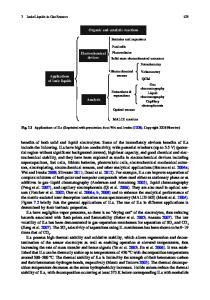Flexible design of ionic liquids for membrane interactions
- PDF / 579,061 Bytes
- 4 Pages / 595.276 x 790.866 pts Page_size
- 72 Downloads / 342 Views
REVIEW
Flexible design of ionic liquids for membrane interactions Lena Rakers 1 & Frank Glorius 1 Received: 26 February 2018 / Accepted: 5 March 2018 # International Union for Pure and Applied Biophysics (IUPAB) and Springer-Verlag GmbH Germany, part of Springer Nature 2018
Abstract In the last years, ionic liquids gained a lot of interest in materials sciences. Especially their interactions with biomolecules like lipids or proteins became more and more fascinating. One substance class of ionic liquids are imidazolium salts, which are usually known as the precursors of the more prominent N-heterocyclic carbenes (NHCs). Due to their high stability and easy synthesis, imidazolium salts became more attractive for applications in biological systems. In 2015, imidazolium salts bearing long alkyl chains in their backbone were established as lipid analogs. Interestingly, different effects of the intercalation into a membrane can be observed depending on the characteristics of the structure. Within this tutorial, we would like to highlight the modular synthesis of these compounds leading to a versatile tool box of lipid analogs that can be adjusted depending on the required needs. Keywords Ionic liquid . Synthesis . Lipid analogs . Imidazolium salts
Introduction Recently, ionic liquids became increasingly attractive tools in different fields of materials science including their application as for example solvents (Kuchenbuch and Giernoth 2015; Vekariya 2017) or electrolytes (Armand et al. 2009; Watanabe et al. 2017). Moreover, special attention was given to their fascinating interactions with biomolecules like phospholipids or proteins and their potential application as candidates in medicinal chemistry (Sivapragasam et al. 2016; Benedetto and Ballone 2016; Egorova et al. 2017 Benedetto 2017). A prominent class of compounds within this library of ionic liquids is imidazolium salts, which can be easily tuned depending on the required characteristics to lead to a high structural diversity. Furthermore, they show a great stability and can be employed as precursors for the well-known Nheterocyclic carbenes (NHCs) for example as ligands in transition metal catalysis (Hopkinson et al. 2014; De Fremont
This article is part of a Special Issue on Ionic Liquids and Biomolecules edited by Antonio Benedetto and Hans-Joachim Galla * Frank Glorius glorius@uni–muenster.de 1
Institute of Organic Chemistry, University of Münster, Corrensstrasse 40, 48149 Münster, Germany
et al. 2009; Hermann 2002). In addition to their application in organometallic chemistry, interesting interactions with biomolecules were observed (Riduan and Zhang 2013; Benedetto and Ballone 2016; Egorova et al. 2017; Benedetto 2017; Gravel and Schmitzer 2017). In 2015, we designed and synthesized a class of long alkyl chain containing imidazolium salts and analyzed their interactions with 1,2-dipalmitoyl-sn-glycero-3-phosphocholine (DPPC) membranes via biophysical measurements (Wang et al. 2015a, b; Wang et al. 2016; Rühling et al. 2017; Drücker et al. 2017). In c
Data Loading...











